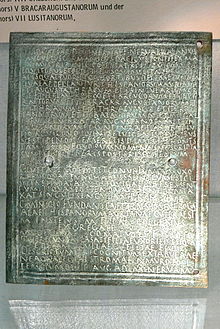Cohors III Batavorum
The Cohors III Batavorum [Antoniniana] [milliaria] [equitata] ( German 3rd cohort of the Batavians [the Antoninian] [1000 men] [partly mounted] ) was a Roman auxiliary unit . It is attested by military diplomas and inscriptions.
Name components
- Batavorum : The soldiers of the cohort were recruited from the Batavian people when the unit was set up .
- milliaria : 1000 men. Depending on whether it is an infantry cohort ( Cohors milliaria peditata ) or a mixed association of infantry and cavalry ( Cohors milliaria equitata ), the nominal strength of the unit was either 800 or 1040 men. In the military diplomas, the symbol is used instead of milliaria .
- equitata : partially mounted. The unit was a mixed association of infantry and cavalry. The addition appears in the inscription ( AE 1935, 163 ).
The unit was a Cohors milliaria equitata . The nominal strength of the unit was therefore 1040 men, consisting of 10 Centurien infantry with 80 men each and 8 tower cavalry with 30 riders each.
history
The unity is evidenced in the province of Britannia by two Vindolanda tablets (263, 567) which can be dated to the late 90s and early 100s.
The first evidence of unity in Raetia province is based on a military diploma dated to AD 107. In the diploma, the cohort is listed as part of the troops (see Raetisches Heer ) that were stationed in Raetia. Two other military diplomas, dated 116, prove unity in the same province.
According to Barnabás Lőrincz , the unit took part in Trajan's Parthian War and then came to Pannonia . The first evidence of unity in the province of Pannonia Inferior is based on a military diploma dated 135. In the diploma, the cohort is listed as part of the troops (see Roman Forces in Pannonia ) that were stationed in Pannonia Inferior. Other military diplomas dated 143, 148, 157, 159, 178/190 and 193 prove unity in the same province.
Locations
Cohort locations in Britannia may have been:
- Vindolanda (Chesterholm): Several Vindolanda plaques prove the presence of members of the cohort in Vindolanda between 98 and 102/103; the stationing of the unit in Vindolanda is not guaranteed.
Locations of the cohort in Pannonia were:
- Vetus Salina ( Adony ): Bricks with the stamp COH III B or COH III BAT (A) as well as inscriptions prove the presence (of parts) of the cohort in Adony.
The locations of the cohort in Raetia were:
- Sorviodurum ( Straubing ):
Members of the cohort
The following members of the cohort are known.
Commanders
|
|
Others
See also
Web links
- Vindolanda Tablets Online. vindolanda.csad.ox.ac.uk, accessed on March 13, 2017 .
Remarks
- ↑ See in the article the section Roman troops in Straubing as well as the individual references and literature given there.
Individual evidence
- ↑ a b c d e f g John Spaul: Cohors² The evidence for and a short history of the auxiliary infantry units of the Imperial Roman Army , British Archaeological Reports 2000, BAR International Series (Book 841), ISBN 978-1841710464 , p. 205-206, 212
- ^ A b The Roman Army: Military Units. Vindolanda Tablets Online, accessed March 13, 2017 .
- ↑ a b Jörg Scheuerbrandt : Exercitus. Tasks, organization and command structure of Roman armies during the imperial era. Dissertation, Albert-Ludwigs-Universität Freiburg im Breisgau 2003/2004, p. 160, 163 tables 4.7 ( PDF p. 162, 165 ).
- ↑ a b Military diplomas of the years 107 ( CIL 16, 55 ), 116 ( RMD 3, 155 , AE 1995, 1185 ), 135 ( RMD 4, 251 ), 143 ( RMD 4, 266 ), 148 ( CIL 16, 179 , CIL 16, 180 ), 157 ( RMD 2, 102 , RMD 2, 103 ), 159 ( CIL 16, 113 ), 178/190 ( CIL 16, 131 ) and 193 ( RMD 5, 447 ).

